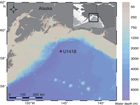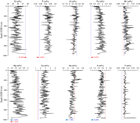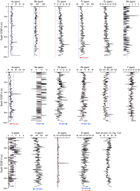Jaeger, J.M., Gulick, S.P.S., LeVay, L.J., and the Expedition 341 Scientists
Proceedings of the Integrated Ocean Drilling Program Volume 341
publications.iodp.org
https://doi.org/10.2204/iodp.proc.341.206.2020
Data report: wavelength-dispersive X-ray fluorescence–based geochemical data, Site U1418, IODP Expedition 341, Gulf of Alaska1
Mark Zindorf,2 Christian März,3, 4 and Bernhard Schnetger5
Keywords: Integrated Ocean Drilling Program, JOIDES Resolution, Expedition 341, Southern Alaska Margin Tectonics, climate and sedimentation, Site U1418, wavelength-dispersive X-ray fluorescence
MS 341-206: Received 21 November 2019 · Accepted 26 February 2020 · Published 29 April 2020
Abstract
Integrated Ocean Drilling Program (IODP) Site U1418 was drilled during Expedition 341 in 2013. The site is situated on the Surveyor Fan, one of the largest deep-sea fans in the world. The site was drilled to 972 m below seafloor, and a sediment record spanning ~1.2 My was attained. For this study, 285 sediment samples were analyzed for bulk geochemical composition using wavelength-dispersive X-ray fluorescence (XRF). Records for the major elements Al, Ca, Fe, K, Mg, Mn, Na, P, Si, and Ti and minor elements As, Ba, Co, Cr, Cu, Mo, Ni, Nb, Pb, Rb, Sr, Y, V, U, Zn, and Zr are presented, as well as data for total carbon and total organic carbon analyzed by elemental analyzer.
Introduction
Integrated Ocean Drilling Program (IODP) Site U1418 is one of five sites drilled during Expedition 341 in the Gulf of Alaska and is situated on the proximal Surveyor Fan at a water depth of 3703 m (Figure F1). The 972 m cored interval analyzed here (based on a splice of samples from Holes U1418A, U1418B, U1418D, and U1418F) represents a depositional history of ~1.2 My according to the shipboard age model (Jaeger et al., 2014a). Site U1418 was primarily drilled to obtain a paleoclimate record in the Gulf of Alaska.
The chemical composition of sediment core samples can be used to investigate a broad variety of environmental or chemical processes: changes in bulk sediment composition over depth/time can reflect a change in the source area of the detrital material. Enrichment of specific elements such as Si or Ba can be associated with organic material and caused by higher bioproductivity (Goldberg and Arrhenius, 1958; DeMaster, 1981; Von Breymann et al., 1992). Elements such as Si, Ti, and Zr can be associated with larger grain sizes (quartz) or heavy minerals (Wedepohl, 1971). Enrichments of specific diagenetically active elements (Ca, Ba, and Fe) and trace metals (Co, Cr, Cu, Mo, Ni, V, and U) in specific horizons can indicate authigenic mineral formation and thus suggest past or present diagenetic reactions (e.g., Riedinger et al., 2006; Torres et al., 1996; Wehrmann et al., 2016).
For provenance studies, general composition of multiple elements can be compared to the composition of specific lithologies on land (Haughton et al., 1991). In the Gulf of Alaska, the main lithologies delivering detrital material to the ocean are situated in the Chugach-St. Elias Coastal range, as determined for the more coast-proximal Site U1419 in geologically recent times (Barker et al., 1992; Penkrot et al., 2018). To reveal if an unusual enrichment or depletion of a specific element exists, comparison to Average Shale (Wedepohl, 1991, 1971) as a first assessment is useful.
Sedimentary carbon content can provide information on changes in carbon deposition and preservation. Changes in total organic carbon can be an indicator of variations in past bioproductivity or preservation/degradation of deposited organic material (Hedges and Keil, 1995). Inorganic carbon can indicate changes in carbonate shell deposition (e.g., from foraminifers) or formation of authigenic carbonates in diagenetically active zones (Hathaway and Degens, 1969).
Here, we present bulk inorganic geochemical data alongside total and organic carbon from Site U1418 in the Gulf of Alaska.
Methods and materials
A total of 285 sediment samples from Holes U1418A, U1418B, U1418D, and U1418F were taken on board the R/V JOIDES Resolution to provide a continuous sediment record over the entire cored interval. Samples are either cubes previously used for paleomagnetic analyses (179 samples) or squeeze cakes used for pore water extraction (105 samples). Thus, the individual samples integrate over different sediment intervals: a paleomagnetic cube has an edge length of 2 cm, whereas a squeeze cake covers 5–30 cm of a whole-round core. Sample type for each individual sample as well as sample length is indicated in the data set (see XRF in Supplementary material). Samples were freeze-dried and homogenized with an agate mortar and pestle. From each sample, 700 mg was mixed with 4200 mg dilithiumtetraborate, preoxidized with 1 g ammonium nitrate at 500°C and then fused to homogeneous glass beads. The glass beads were analyzed by wavelength-dispersive X-ray fluorescence (XRF) (Panalytical Axios Max, 3 kW) for major and minor elements (Si, Ti, Al, Fe, Mn, Mg, Ca, Na, K, P, As, Ba, Co, Cr, Cu, Mo, Ni, Nb, Pb, Rb, Sr, Y, V, U, Zn, and Zr). The XRF was calibrated with 52 standard reference materials (SRMs) and in-house standards. Average absolute errors are listed in Table T1 along with average concentrations of each element. Major elements are reported as oxides and converted to elemental values using a conversion factor reported in Table T1 (e.g., [Si] = [SiO2] × 0.4674).
Total carbon (TC) and total organic carbon (TOC) were analyzed using a Leco combustion analyzer. Total inorganic carbon (TIC) was calculated as the difference between TC and TOC. Reproducibility was better than 5% for TC and 10% for TOC, as determined by analyzing duplicates of every tenth sample. Average results can be found in Table T2.
All results are presented in weight percent or parts per million of dry sediment weight. Sample depth indications are given in meters below seafloor (mbsf) on the CCSF-A (core composite depth below seafloor, as described in the Methods chapter [Jaeger et al., 2014b]) depth scale. This represents a continuous composite depth scale combining all drilled holes into a splice.
Results
Inorganic elemental geochemistry
Consistent across all geochemical data is that there are no abrupt changes or breaks observed that could be linked to distinct paleoclimatic or diagenetic events. All elements show consistently small variations throughout the core except P and Ni. In the P record, major narrow peaks exist that exceed the background signal 2- to 5-fold. These peaks could represent past diagenetically active zones where P minerals precipitated. Nickel has a peak at 430 mbsf. This peak could represent a volcanic ash layer. However, no such layer was detected in this interval during sedimentological core description (Jaeger et al., 2014c). Most elements do not exhibit obvious upcore or downcore trends except Fe, Mg, Co, Cr, Cu, and V, which increase downcore, and Al and Zr, which show a mild downcore decrease. The minor elements Mo and Nb are close to the quantification limit and thus only take discrete values in 1 ppm steps.
Strong correlations (correlation coefficient [r] > 0.8) exist between elements Fe and Mg (r = 0.85), Fe and V (r = 0.88), Mg and V (r = 0.82), Ba and Ce (r = 0.88), and K and Rb (r = 0.95).
The general chemical composition of sediment material from Site U1418 shows no stronger similarity to Average Shale (AS; Wedepohl, 1971) than to the composition of the Chugach Formation (CT; Barker et al., 1992). Elements such as Si, Ti, Fe, Mn, Mg, Ca, Co, and Cr are closer to AS than to CT. The elements K, Al, Nb, Rb, Sr, and U are closer to CT than to AS. For several elements, authigenic enrichments (Fe, Mn, Ca, Co, Cr, U) or a biogenic component (Si, Ca) can obscure a signal of the terrigenous source area. Except for Si and U, these elements are also more strongly enriched relative to both comparison materials, making such an interpretation plausible.
Average contents, standard deviations, minima and maxima, and quantification limits for all elements can be found in Table T1. Plots for each element are shown in Figures F2 (major elements) and F3 (minor elements).
Inorganic and organic carbon
Total carbon generally decreases from ~1 wt% at the top of the core to ~0.8 wt% at the bottom (Figure F4). Intersample variability is generally higher than the overall trend. TOC decreases from core top to bottom from ~0.5 to ~0.3 wt%. The variability decreases below 500 mbsf. TIC, which is the difference between TC and TOC, has values ~0.4 wt% and varies between 0 and 0.7 wt%. TIC does not exhibit a downcore trend or an observable change in variability. Thus, it can be assumed that the downcore decrease in TC is dominantly caused by decreasing TOC contents. This could be caused either by variations in organic matter deposition or by the slow microbial conversion of refractory organic matter to natural gas (see methane profile in Jaeger et al., 2014c).
Average contents, minima, and maxima for each carbon fraction can be found in Table T2.
Acknowledgments
Samples were provided by the International Ocean Discovery Program (IODP). Thanks to editor Leah LeVay and reviewer Michelle Penkrot for revising this manuscript. Their suggestions significantly helped improve the work. The authors also thank the captain, crew, and scientific party of IODP Expedition 341 and Leah LeVay, Sean Gulick, and John Jaeger for organizing and implementing Expedition 341. Further thanks go to Carola Lehners and Eleonore Gründken at the Ifremer-Centre de Brest Oldenburg and Phillip Green at the University of Newcastle for supporting the analytical work. The work was funded by the School of Civil Engineering and Geosciences at Newcastle University.
References
Barker, F., Farmer, G.L., Ayuso, R.A., Plafker, G., and Lull, J.S., 1992. The 50 Ma granodiorite of the eastern Gulf of Alaska: melting in an accretionary prism in the forearc. Journal of Geophysical Research: Solid Earth. 97(B5):6757–6778. https://doi.org/10.1029/92JB00257
DeMaster, D.J., 1981. The supply and accumulation of silica in the marine environment. Geochimica et Cosmochimica Acta, 45(10):1715–1732. https://doi.org/10.1016/0016-7037(81)90006-5
Goldberg, E.D., and Arrhenius, G.O.S., 1958. Chemistry of Pacific pelagic sediments. Geochimica et Cosmochimica Acta, 13(2–3):153–212. https://doi.org/10.1016/0016-7037(58)90046-2
Hathaway, J.C., and Degens, E.T., 1969. Methane-derived marine carbonates of Pleistocene age. Science, 165:690–692. https://doi.org/10.1126/science.165.3894.690
Haughton, P.D.W., Todd, S.P., and Morton, A.C., 1991. Sedimentary provenance studies. Special Publication - Geological Society of London, 57:1–11. https://doi.org/10.1144/GSL.SP.1991.057.01.01
Hedges, J.I., and Keil, R.G., 1995. Sedimentary organic matter preservation: an assessment and speculative synthesis. Marine Chemistry, 49(2–3):81–115. https://doi.org/10.1016/0304-4203(95)00008-F
Jaeger, J.M., Gulick, S.P.S., LeVay, L.J., Asahi, H., Bahlburg, H., Belanger, C.L., Berbel, G.B.B., Childress, L.B., Cowan, E.A., Drab, L., Forwick, M., Fukumura, A., Ge, S., Gupta, S.M., Kioka, A., Konno, S., März, C.E., Matsuzaki, K.M., McClymont, E.L., Mix, A.C., Moy, C.M., Müller, J., Nakamura, A., Ojima, T., Ridgway, K.D., Rodrigues Ribeiro, F., Romero, O.E., Slagle, A.L., Stoner, J.S., St-Onge, G., Suto, I., Walczak, M.H., and Worthington, L.L., 2014a. Expedition 341 summary. In Jaeger, J.M., Gulick, S.P.S., LeVay, L.J., and the Expedition 341 Scientists, Proceedings of the Integrated Ocean Drilling Program, 341: College Station, TX (Integrated Ocean Drilling Program). https://doi.org/10.2204/iodp.proc.341.101.2014
Jaeger, J.M., Gulick, S.P.S., LeVay, L.J., Asahi, H., Bahlburg, H., Belanger, C.L., Berbel, G.B.B., Childress, L.B., Cowan, E.A., Drab, L., Forwick, M., Fukumura, A., Ge, S., Gupta, S.M., Kioka, A., Konno, S., März, C.E., Matsuzaki, K.M., McClymont, E.L., Mix, A.C., Moy, C.M., Müller, J., Nakamura, A., Ojima, T., Ridgway, K.D., Rodrigues Ribeiro, F., Romero, O.E., Slagle, A.L., Stoner, J.S., St-Onge, G., Suto, I., Walczak, M.H., and Worthington, L.L., 2014b. Methods. In Jaeger, J.M., Gulick, S.P.S., LeVay, L.J., and the Expedition 341 Scientists, Proceedings of the Integrated Ocean Drilling Program, 341: College Station, TX (Integrated Ocean Drilling Program). https://doi.org/10.2204/iodp.proc.341.102.2014
Jaeger, J.M., Gulick, S.P.S., LeVay, L.J., Asahi, H., Bahlburg, H., Belanger, C.L., Berbel, G.B.B., Childress, L.B., Cowan, E.A., Drab, L., Forwick, M., Fukumura, A., Ge, S., Gupta, S.M., Kioka, A., Konno, S., März, C.E., Matsuzaki, K.M., McClymont, E.L., Mix, A.C., Moy, C.M., Müller, J., Nakamura, A., Ojima, T., Ridgway, K.D., Rodrigues Ribeiro, F., Romero, O.E., Slagle, A.L., Stoner, J.S., St-Onge, G., Suto, I., Walczak, M.H., and Worthington, L.L., 2014c. Site U1418. In Jaeger, J.M., Gulick, S.P.S., LeVay, L.J., and the Expedition 341 Scientists, Proceedings of the Integrated Ocean Drilling Program, 341: College Station, TX (Integrated Ocean Drilling Program). https://doi.org/10.2204/iodp.proc.341.104.2014
Penkrot, M.L., Jaeger, J.M., Cowan, E.A., Walczak, M.H., Mix, A.C., and LeVay, L., 2018. Tectonic and climate influences on spatial and temporal variations of subglacial erosion; Bering Glacier, Alaska [presented at the 2019 American Geophysical Union Fall Meeting, San Francisco, CA, 9–13 December 2019]. (Abstract C51E-1119) https://agu.confex.com/agu/fm18/meetingapp.cgi/Paper/433824
Riedinger, N., Kasten, S., Gröger, J., Franke, C., and Pfeifer, K., 2006. Active and buried authigenic barite fronts in sediments from the Eastern Cape Basin. Earth and Planetary Science Letters, 241(3–4):876–887. https://doi.org/10.1016/j.epsl.2005.10.032
Schlitzer, R., 2015. Ocean Data View. http://odv.awi.de
Torres, M.E., Bohrmann, G., and Suess, E., 1996. Authigenic barites and fluxes of barium associated with fluid seeps in the Peru subduction zone. Earth and Planetary Science Letters, 144(3–4):469–481. https://doi.org/10.1016/S0012-821X(96)00163-X
von Breymann, M.T., Emeis, K.-C., and Suess, E., 1992. Water depth and diagenetic constraints on the use of barium as a palaeoproductivity indicator. In Summerhayes, C.P., Prell, W.L., and Emeis, K.-C. (Eds.), Upwelling Systems: Evolution Since the Early Miocene. Geological Society Special Publication, 64:273–284. https://doi.org/10.1144/GSL.SP.1992.064.01.18
Wedepohl, K.H., 1971. Environmental influences on the chemical composition of shales and clays. Physics and Chemistry of the Earth, 8:307–333. https://doi.org/10.1016/0079-1946(71)90020-6
Wedepohl, K.H., 1991. Chemical composition and fractionation of the continental crust. Geologische Rundschau, 80:207–223. https://doi.org/10.1007/BF01829361
Wehrmann, L.M., Ockert, C., Mix, A.C., Gussone, N., Teichert, B.M.A., and Meister, P., 2016. Repeated occurrences of methanogenic zones, diagenetic dolomite formation and linked silicate alteration in southern Bering Sea sediments (Bowers Ridge, IODP Exp. 323 Site U1341). Deep Sea Research, Part II: Topical Studies in Oceanography, 125–126:117–132. https://doi.org/10.1016/j.dsr2.2013.09.008
1 Zindorf, M., März, C., and Schnetger, B., 2020. Data report: wavelength-dispersive X-ray fluorescence–based geochemical data, Site U1418, IODP Expedition 341, Gulf of Alaska. In Jaeger, J.M., Gulick, S.P.S., LeVay, L.J., and the Expedition 341 Scientists, Proceedings of the Integrated Ocean Drilling Program, 341: College Station, TX (Integrated Ocean Drilling Program). https://doi.org/10.2204/iodp.proc.341.206.2020
2 Ifremer-Centre de Brest, Laboratoire Environnement Profond, France. mark@zindorf.de
3 School of Earth and Environment, University of Leeds, United Kingdom.
4 Also at: School of Natural and Environmental Sciences, Newcastle University, United Kingdom.
5 Institut für Chemie und Biologie des Meeres (ICBM), Universität Oldenburg, Germany.
This work is distributed under the Creative Commons Attribution 4.0 International (CC BY 4.0) license. 



